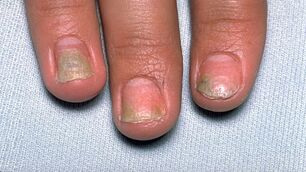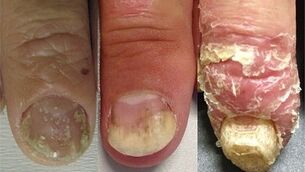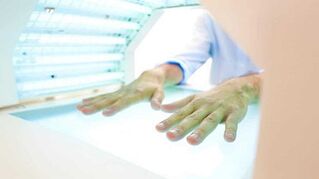One of the varieties of a dermatological disease that occurs in a chronic form is psoriasis of the nails. It can upset an adult or a child if there are suitable factors for its spread. The disease has many similarities with ordinary psoriasis, as it is also characterized by pathological superposition of cells on top of each other, which leads to a strong deformation of the nail plates.
Causes of the disease

Some people find that nail psoriasis or toenail psoriasis occurs under severe stress. Although it has been scientifically proven that strong emotional experiences are not capable of leading to such changes. Therefore, they can not be considered the main cause of the development of the disease. Doctors identify 2 factors that can actually lead to a pathological process:
- Disruption of the immune system,which is responsible for the formation of healthy cells and the fermentation of substances. Such changes do not allow skin particles to develop fully. They start to grow and overlap. The result is thickening of the nail plates;
- Predisposition to the development of psoriasis.In most patients, the propensity to develop pathology is inherent in the genes. He wakes up immediately after the body is negatively affected by certain factors.
Several factors can lead to the activation of the disease:
- Hormonal failure;
- Metabolic problems;
- Long term use of anti-inflammatory drugs and beta-blockers;
- Climatic conditions (cold and dry weather);
- Chronic fatigue;
- Infectious lesions;
- Damage to the upper layers of the skin.
In half of the cases, psoriasis of the fingernails or toenails develops with the skin lesions.
Psoriasis can only affect the fingernails or in addition to other parts of the body.
The first signs of psoriasis on the fingernails and toenails
Nail lesions in psoriasis can be recognized by the characteristic symptoms of this condition. They begin to bother a person from the first days of the development of the disease. Common signs of a disease process include:
- Teeth and grooves on the surface of the nail plates;
- Change the color of the nail to a darker color;
- Inflammatory process along the edge of the nails;
- Itching felt on the skin of the fingers.
If treatment is not started at the initial stage of the disease, it will continue to develop and its clinical manifestations will become more pronounced.
Stages of the disease

What nail psoriasis looks like, you can tell if you carefully study the photo showing the affected plaques and fingers. At the initial stage of development, the manifestation of pathology is not too pronounced. An increase in symptoms is observed with the successful spread of psoriasis, in which healthy tissue is affected.
Doctors distinguish 3 main stages in the development of psoriasis of the nails:
- Progressive.At this point, the nail begins to cover itself with small dots, which are painted in a white or yellowish-brown shade. Over time, the papules increase in size. At this point, psoriasis does not affect the deep layers of the nail, so it can be healed quickly. There is no pain when pressing on the affected area, but its surface gradually peels;
- Stationary.The dots stop appearing on the nails. Along with this, inflammatory processes slow down. However, the discomfort or pain persists. Sometimes at this stage, the skin next to the plaques is covered with rashes characteristic of the disease. It becomes very dry itself;
- Regressive.Previously formed rashes actively disappear. Whitish edges appear near the lesions. As a rule, at this stage of the development of psoriasis, patients experience unbearable itching.
By observing the development of a disease, doctors should already understand what stage it is at. This will help them find the most optimal therapy for the patient.
If left untreated, psoriasis will spread to new areas.
Diagnostic methods
An experienced specialist who diagnoses and treats dermatological diseases can immediately determine if a person has nail psoriasis. Laboratory studies verify the accuracy of the conclusions drawn. To make a diagnosis, you may need to:
- Complete blood count;
- Analysis of biopsy or psoriatic scales.
Instrumental diagnosis of nail psoriasis is not required.
How to treat nail psoriasis

Psoriasis of the nails in children and adults requires complex treatment. A tool or procedure for such a diagnosis is not enough. Treatment for psoriasis of the nails on the hands or feet is standard for all patients. On an individual basis, these are selected drugs and physiotherapy. In addition, the patient will be asked to review their daily diet and make significant adjustments to their usual lifestyle. After all, the success of the therapeutic course also depends on it.
As soon as a person notices signs of psoriasis to the nails, they should immediately see a dermatologist. The type of symptoms that will help recognize the disease has been discussed above.
Most doctors prescribe topical ointments and systemic tablets
Drug treatment
For a disease like psoriasis of the nails, treatment can be done at home. The doctor will prescribe a number of medicines for you which must be taken orally or applied to the affected areas.
In the early stages of dermatological pathology, a topical agent should be used. Ointments and creams can be hormonal or non-hormonal. The former are in demand for advanced forms of the disease.
Non-hormonal drugs rarely cause side effects and complications. In addition, they do not lead to addiction, unlike more aggressive preparations for the external treatment of nail plate.
If a patient has severely affected nail disease, the doctor will recommend oral medication. He will also tell you how to treat nail psoriasis in this way and what dosage to take.
The following medications may be needed for nail psoriasis:
- Immunomodulators (vitamins);
- Antihistamines;
- Sedatives.
In most cases, drugs are not stopped until the disease is gone.
Physiotherapy

Psoriasis of the fingernails is often treated with physiotherapy. A good result for such violations is given by:
- PUVA therapy;
- X-ray therapy;
- UV irradiation;
- Ultrasound therapy;
- Laser therapy.
In order for the result to be positive only after the procedures, it is necessary to correctly select the number and duration of physiotherapy sessions. This task should be entrusted to an experienced professional. Otherwise, the patient who is trying to figure out how to cure psoriasis will experience serious side effects from procedural treatment.
PUVA therapy is one of the most modern and effective methods.
Adequate nail care
In order for the treatment to be as effective as possible, the patient with psoriasis should pay attention to proper nail care. The disease seriously injures their plate, so such care will not be superfluous. First of all, it consists in respecting the rules of hygiene. Doctors recommend doing the following for this diagnosis:
- The nails should be cut as short as possible;
- During household chores, it is advisable to wear protective gloves;
- Avoid work that could injure the nails and the skin around them;
- You should regularly check the cleanliness of the nail plates.
Medical methods will be more effective if, in addition to folk and traditional methods of therapy, the patient observes these rules.
In psoriasis, it is especially important to protect your hands from aggressive exposure.
Folk remedies
Experts in traditional medicine know which herb cures psoriasis affecting nail plate. They recommend it, like many other herbs, when preparing home remedies for the treatment of dermatological diseases.
Patients can use the following folk remedies:
- Celandine broth.To prepare it you need to pour 0, 5 liters of water 2 tbsp. l. herbs. This mixture should be brought to a boil over low heat. On average, it should cook for about 30 minutes. After that, medicinal baths are prepared from the broth in which the arms and legs are lowered for 20-25 minutes;
- Natural oils.These foods work well with psoriasis. Sea buckthorn oil is particularly beneficial. It hydrates the skin around the nails and enriches them with beneficial trace elements. To treat the affected area with oil, you just need to apply it to a cotton ball and then walk it on the plaque. It is recommended to repeat the procedure up to 3 times a day;
- Onion compress.It is made from a medium onion, which has previously passed through a meat grinder. The resulting oatmeal is placed on the nails and covered with a clean gauze bandage. The compress should be left in place for 30 minutes;
- Decoction of laurel.It can also be used when preparing medicinal baths. To make a broth, you need to pour 2 cups of hot water with 20 g of herb. Cook the mixture for no more than 10 minutes. Then the product is cooled to a comfortable temperature, and the hands or feet are lowered into it. It is also allowed to take such a decoction inside, 40 g three times a day;
- Herbal decoction.For baths, you can prepare a remedy based on celandine, chamomile, oak bark, sage and string. They do it the same way as in the previous recipe;
- Herbal infusion.It is intended for oral administration. Homemade medicine is made from lingonberry leaves, St. John's wort, calamus root, celandine and string. The ingredients are taken in equal proportions. The infusion is made from 1 tbsp. l. collection and a glass of boiling water. It is recommended to take 50 g of the drug 2 times a day.
Folk remedies should be used in conjunction with traditional treatments. Otherwise, they will have no effect.
Therapeutic diet

When the top layers of a person's skin are affected, poor nutrition can be the cause. Because of this, the body lacks beneficial trace elements that support the immune system and other systems. And as you know, due to failures, psoriatic disease occurs. Nails with psoriasis can be treated with a special diet. It must be hypoallergenic.
The nutrition of a patient with psoriasis of the nails should be balanced. It is strongly recommended to exclude foods that may cause allergies. These are chocolate, strawberries, citrus fruits and coffee. You will also have to forgo salty, smoked, pickled, spicy and fatty treats. Ketchup, mayonnaise and mustard are prohibited.
During periods of exacerbation of an autoimmune disease, it is recommended to follow a mono-diet, designed for 1-2 days. Such nutrition involves the use of only one product. It can be apples, kefir, fish or grains.
A therapeutic diet should be fortified with fermented milk products, fruits, vegetables, herbs and lean fish.
Foods that can cause allergies can also exacerbate psoriasis.
Prevention
It is much easier to try to prevent the development of nail psoriasis than to fight it later. Disease prevention involves following a number of recommendations:
- You must include plant foods in your diet;
- It is necessary to abandon fried, smoked, pickled and salted foods;
- It is advisable to rest regularly in places with a favorable climate for the skin and the body as a whole;
- Take vitamin and mineral complexes in classes;
- Avoid damaging the skin and nail plates;
- Treat infectious diseases in a timely manner.
Remember to take care of your skin and nails. This is the only way to protect yourself from the development of psoriasis and its relapses.
Forecast
Psoriasis is one of the diseases that is constantly progressing. Medication and physiotherapy only temporarily stop the development process. Not a single person has been able to make a full recovery. If the patient adheres to the recommendations of a specialist, he can avoid repeated damage to the skin and nails.
Complications and consequences
Psoriatic lesions of the nails should be treated from the first days of its development. If treatment is absent or has been improperly chosen, the patient may face the complications and consequences of an autoimmune disease.
With nail psoriasis, the cardiovascular system can be seriously affected. These are the vessels that threaten the greatest danger, since pathological changes occur in them under the influence of the disease.
Any form of psoriasis can cause psychological problems. They are directly related to the fact that others rarely normally relate to a person with similar defects on different parts of the body. Due to this, the patient turns in on himself, begins to abuse alcohol, he is constantly pursued by a depressive state. Against the background of a disturbed psyche, the probability of the appearance of malignant processes in the cells of the skin increases.























